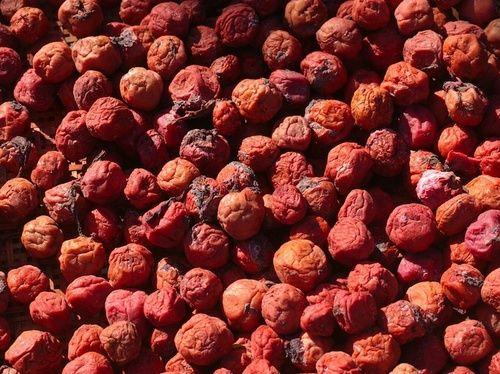L'umeboshi is a typical Japanese salted fruit used since ancient times for medicinal properties. Rich in organic acids, it is highly alkalizing and helps the liver and the liver functions. Let's find out better.
> Properties and characteristics
> How umeboshi is used in the kitchen

What is umeboshi?
The term Umeboshi - literally "prunes”- refers to a typical Japanese salted fruit with an extremely acid and salty flavor, used since ancient times and with renowned medicinal properties. The fruits used for umeboshi are actually more like an apricot than a plum e come from an Asian variety of the Prunus Mume apricot; there are many varieties with a different flavor and a more or less wrinkled appearance.
The center of Japan's umemoshi industry is located in Wakayama Prefecture on the island of Honshu. Here, in fact, thanks to the extremely temperate climatic conditions and the abundant rains, the largest number of plum trees in the country grows.
The plums they are harvested at the end of June, when they are still green and their juice has the maximum acidity level; they are then washed and immersed in water for one night to remove the bitter taste; then the fruits are placed in special containers, arranged in layers, covered with salt and crushed by a weight, and placed in a cool and dark place, where the salt is left to do the work of extracting the juice and the process of natural fermentation.
In these conditions the growth of beneficial citric acid bacteria is promoted and the development of harmful microorganisms and enzymes is inhibited. At the end of July the plums are removed from the tubs and left to dry in the air. The fruits are now ready, but generally they are soaked in plum vinegar mixed with the red and fragrant leaves of the shiso plant, and it is thanks to these leaves that the distinctive red color of umeboshi is obtained. They then break up season the fruits for at least one year in order to allow the development of their so intense and peculiar flavor.
Properties and characteristics
The origin of these salted plums is not certain, but one of the theories finds traces of them in ancient China, where a dried and smoked plum (ubai) was found in a tomb of more than two thousand years. Ubai is one of the oldest Chinese medicines and is still in use for a variety of medical purposes. In Japan, at the time of the samurai, these salted plums were one of the most precious foods for soldiers, who ate them with rice and drinks such as antidote to fatigue of battles and as a water purifier.
In addition to the dramatic and sour taste, umeboshi possesses remarkable medical properties, they are rich in organic acids (citric acid and phosphoric acid) which help a rapid breakdown of harmful acids such as lactic acid and pyruvic acid sometimes present in excess in the body.
Paradoxically, its high acidity has an effect strongly alkalizing and is able to help maintain a healthy balance between acid and alkaline environments in situations such as fatigue, pregnancy sickness, motion sickness or seasickness, nausea and stomach problems. This quality of umeboshi has allowed it to earn the name of "Japanese Alkaselzer" or "king of alkaline foods”And the reputation of being a perfect ally of digestion, promoting the elimination of toxins and stimulating the appetite.
Furthermore, it is believed that support liver function and help the liver process alcohol making it a great natural hangover cure.
In the Japanese tradition it is considered as a powerful preventive medicine, able to neutralize the sense of fatigue and tone the body. Slowly then the folkloric character has developed that attributes to umeboshi the ability to prevent and cure various diseases, somewhat equivalent to the apple in Western countries, and to the proverbial expression “an apple a day keeps the doctor away”.
Umeboshi is also said to be very effective in cases of anemia, preventing fatigue, relieving constipation and cold symptoms and flu, and thanks to its natural antibiotic and antiseptic properties it is used as a water purifier and in cases of food poisoning.
It can also be used to treat skin conditions, such as eczema. In this case the fruits are crushed and reduced to a paste that can be spread on the affected skin area. Finally, the umeboshi aged six or seven has the ability to stop episodes of dysentery.
Umeboshi among the natural remedies for nausea: discover the others

How umeboshi is used in the kitchen
In Japan, many people start their day by drinking a cup of green tea and eating a salted plum. It is also used a lot like seasoning for rice, to enrich its flavor and presentation, and in particular accompanied with okayu (a type of rice porridge) as a remedy for colds.
The umeboshi can be consumed whole or powdered to form a condiment called shiso momiji. Given the strong sour and salty taste, most people soak a plum in a cup of hot water or Kukicha / Bancha tea for five minutes and then drink the liquid and eat the fruit.
However, a few, 2 or 3 a week are enough, and they can be kept for a long time.
As an alternative to whole plum, it is possible use umeboshi vinegar and use it as a condiment for soups, stews, stews and salads.
Umeboshi paste can also be used as a topping in combination with various sauces, or simply spread on a slice of toast with avocado and poached eggs or on a cob of corn.
Plum extract called bainiku ekisu, a dark, viscous liquid made from cooked ume plums, is rich in all of the fruit's most active ingredients, but in a concentrated form, and can be added to hot water and honey and drunk as a tonic. cure-all.
Finally, dried plum extract is also sold in tablet form (meitan). However, the best way to use umeboshi is in its whole plum form, little by little and regularly, and above all you have to be careful to buy organic fermented plums following ancient traditions and with the use of organic shiso leaves and salt. marine.
It can certainly be said that umeboshi is a super food that well symbolizes Hippocrates' maxim: "Make food your medicine and medicine be your food".
READ MORE
Umeboshi among strongly alkaline foods: discover the others
Other articles on umeboshi:
> Umeboshi among the ingredients of macrobiotic cuisine
> Among the remedies for nausea in pregnancy, Umeboshi tablets
> 3 recipes with umeboshi acidulate
| Livingwholeness.co.uk | Procare-central.com


























